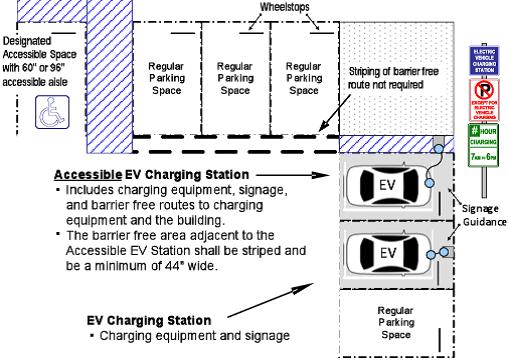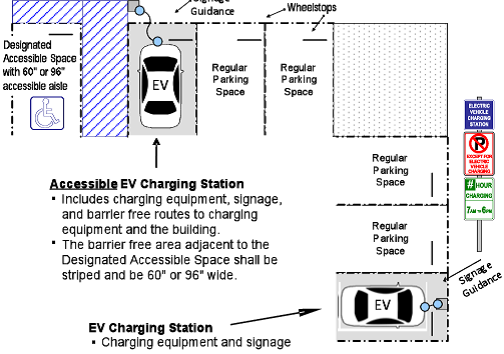Chapter 20.56
ELECTRIC VEHICLE INFRASTRUCTURE
Sections:
20.56.005 Words and phrases defined.
20.56.010 Permitted locations.
20.56.020 Charging and parking.
20.56.030 Accessible features.
20.56.001 Purpose.
The purpose of this chapter is to encourage the use of electric vehicles and to set standards for and expedite the establishment of a convenient, cost-effective electric vehicle infrastructure that such a transition necessitates. (Ord. 2980 § 19, 2011).
20.56.005 Words and phrases defined.
For the purposes of this chapter and other chapters of the municipal code that address electric vehicle infrastructure, the following definitions shall apply.
(1) “Battery charging station” means an electrical component assembly or cluster of component assemblies designed specifically to charge batteries within electric vehicles, which meet or exceed any standards, codes, and regulations set forth by Chapter 19.28 RCW and consistent with rules adopted under RCW 19.27.540.
(2) “Battery electric vehicle (BEV)” means any vehicle that operates exclusively on electrical energy from an off-board source that is stored in the vehicle’s batteries, and produces zero tailpipe emissions or pollution when stationary or operating.
(3) “Battery exchange station” means a fully automated facility that will enable an electric vehicle with a swappable battery to enter a drive lane and exchange the depleted battery with a fully charged battery through a fully automated process, which meets or exceeds any standards, codes, and regulations set forth by Chapter 19.27 RCW and consistent with rules adopted under RCW 19.27.540.
(4) “Charging levels” means the standardized indicators of electrical force, or voltage, at which an electric vehicle’s battery is recharged. Levels 1, 2, and 3 are the most common EV charging levels, and include the following specifications:
(a) Level 1 is considered slow charging, with voltage in the range from zero through 120.
(b) Level 2 is considered medium charging, with voltage in the range from 120 through 240.
(c) Level 3 is considered fast or rapid charging, with voltage greater than 240.
(5) “Electric scooters and motorcycles” means any two-wheel vehicle that operates exclusively on electrical energy from an off-board source that is stored in the vehicle’s batteries and produces zero emissions or pollution when stationary or operating.
(6) “Electric vehicle” means any vehicle that operates, either partially or exclusively, on electrical energy from the grid or an off-board source, and that is stored on board for motive purposes. “Electric vehicle” includes: (a) a battery electric vehicle; (b) a plug-in hybrid electric vehicle; (c) a neighborhood electric vehicle; and (d) a medium-speed electric vehicle.
(7) “Electric vehicle charging station” means a public or private parking space that is served by battery charging station equipment that has as its primary purpose the transfer of electric energy (by conductive or inductive means) to a battery or other energy storage device in an electric vehicle. An electric vehicle charging station equipped with Level 1 or Level 2 charging equipment is permitted outright as an accessory use to any principal use.
(8) “Electric vehicle charging station – restricted” means an electric vehicle charging station that is (a) privately owned and restricted access (e.g., single-family home, executive parking, designated employee parking), or (b) publicly owned and restricted (e.g., fleet parking with no access to the general public).
(9) “Electric vehicle charging station – public” means an electric vehicle charging station that is (a) publicly owned and publicly available (e.g., Park & Ride parking, public library parking lot, on-street parking), or (b) privately owned and publicly available (e.g., shopping center parking, nonreserved parking in multifamily parking lots).
(10) “Electric vehicle infrastructure” means structures, machinery, and equipment necessary and integral to support an electric vehicle, including battery charging stations, rapid charging stations, and battery exchange stations.
(11) “Electric vehicle parking space” means any marked parking space that identifies the use to be exclusively for the parking of an electric vehicle.
(12) “Medium-speed electric vehicle” means a self-propelled, electrically powered four-wheeled motor vehicle, equipped with a roll cage or crush-proof body design, whose speed attainable in one mile is more than 25 miles per hour but not more than 35 miles per hour and otherwise meets or exceeds the federal regulations set forth in 49 CFR 571.500.
(13) “Neighborhood electric vehicle” means a self-propelled, electrically powered four-wheeled motor vehicle whose speed attainable in one mile is more than 20 miles per hour and not more than 25 miles per hour and conforms to federal regulations under 49 CFR 571.500.
(14) “Nonelectric vehicle” means any motor vehicle that does not meet the definition of “electric vehicle.”
(15) “Plug-in hybrid electric vehicle (PHEV)” means an electric vehicle that (a) contains an internal combustion engine and also allows power to be delivered to drive wheels by an electric motor; (b) charges its battery primarily by connecting to the grid or other off-board electrical source; (c) may additionally be able to sustain battery charge using an on-board internal-combustion-driven generator; and (d) has the ability to travel powered by electricity.
(16) “Rapid charging station” means an industrial grade electrical outlet that allows for faster recharging of electric vehicle batteries through higher power levels and that meets or exceeds any standards, codes, and regulations set forth by Chapter 19.28 RCW and consistent with rules adopted under RCW 19.27.540. (Ord. 2980 § 19, 2011).
20.56.010 Permitted locations.
Electric vehicle infrastructure shall be permitted pursuant to this chapter in zoning districts as identified in the table below.
|
Zone |
Levels 1 and 2 Charging Station |
Rapid Charging Station |
Battery Exchange Station |
|---|---|---|---|
|
RS |
P1 |
– |
– |
|
RM |
P1 |
– |
– |
|
OP |
P1 |
P1 |
– |
|
CG |
P |
P |
P |
|
CB |
P |
P |
P |
|
CL |
P |
P |
P |
|
CBD-Core |
P |
P1, 2 |
– |
|
CBD |
P |
P1, 2 |
– |
|
CMX |
P |
P1, 2 |
– |
|
MP |
P |
P |
– |
|
ML |
P |
P |
P |
|
MR |
P |
P |
P |
|
FAIR |
P |
P |
P |
|
PD |
P1 |
– |
– |
|
MED |
P |
P |
P |
|
PF |
P |
ACUP |
ACUP |
|
1 Allowed only as accessory to a principal outright permitted use or permitted conditional use. |
|||
|
2 Only “Electric vehicle charging stations – restricted” as defined in PMC 20.56.005; considered mechanical equipment for purposes of screening. |
|||
(Ord. 2980 § 19, 2011).
20.56.020 Charging and parking.
(1) The intent of this section is to provide guidelines for all parking lot, garage or on-street parking spaces, except those that include restricted electric vehicle charging stations.
(2) Parking Standards.
(a) A standard size parking space may be used as an electric vehicle charging station space.
(b) An electric vehicle charging station space may be included in the calculation for minimum required parking spaces that are required pursuant to other provisions of the municipal code.
(c) No minimum number of charging station spaces is required.
(3) Charging and Parking Restrictions.
(a) Electric vehicle charging stations, where provided for public use, are reserved for parking and charging electric vehicles only.
(b) Electric vehicles may be parked in any space designated for public parking, subject to the restrictions that would apply to any other vehicle that would park in that space.
(c) No person shall stop, stand or park any nonelectric vehicle in a space designated through signage as an electric vehicle charging station. Any nonelectric vehicle is subject to fine or removal.
(d) Any electric vehicle in any designated electric vehicle charging station and that either (i) is not electrically charging or (ii) is parked beyond the days and hours designated on regulatory signs posted at or near the space, shall be subject to a fine and/or removal as posted by the property owner or the property owner’s agent. For purposes of this subsection, “charging” means any electric vehicle is parked at an electric vehicle charging station and is connected to the charging station equipment.
(4) Design Criteria. Where provided, parking for electric vehicle charging purposes shall meet the standards of this subsection.
(a) Signage. Each charging station space available for public use shall have posted signage allowing only charging electric vehicles to park in such spaces. Signage for parking of electric vehicles shall include:
(i) Days and hours of operations if time limits or tow-away provisions are to be enforced.
(ii) Information on the charging station identifying voltage and amperage levels and any time of use, fees, or safety information.
(iii) Installation of directional signs at appropriate decision points to effectively guide motorists to the charging stations space(s).
(b) Maintenance. Charging station equipment shall be maintained in all respects, including the functioning of the charging equipment. A phone number or other contact information shall be provided on the charging station equipment for reporting when the equipment is not functioning or other problems are encountered.
(c) Clearance. Charging station equipment mounted on pedestals, light posts, bollards or other devices shall be a minimum of 24 inches clear from the face of curb.
(d) Charging Station Equipment. Charging station outlets and connector devices shall be no less than 36 inches or no higher than 48 inches from the top of the surface where mounted, and shall contain a retraction device and/or a place to hang permanent cords and connectors sufficiently above the ground or paved surface.
(e) Charging Station Equipment Protection. When the electric vehicle charging station space is perpendicular or at an angle to curb face and charging equipment, adequate equipment protection, such as wheel stops or concrete-filled steel bollards, shall be used.
(f) Location. Placement of a single electric vehicle charging station is preferred at the beginning or end stall on a block face.
(g) Lighting. Where charging station equipment is installed, adequate site lighting shall exist, unless charging is for daytime purposes only.
(5) Data to Be Available. To allow for maintenance and notification, the owners of any private new electric vehicle infrastructure station that will be publicly available shall provide information on the station’s geographic location, date of installation, equipment type and model, and owner contact information. (Ord. 2980 § 19, 2011).
20.56.030 Accessible facilities.
(1) Charging station equipment located adjacent to a pedestrian circulation area, such as a sidewalk or accessible route to a building entrance, shall not interfere with accessibility requirements of WAC 51-50-005.
(2) Where electric vehicle charging stations are provided in parking lots or parking garages, excluding garages in single-family residences, accessible electric vehicle charging stations shall be provided according to the ratios shown in the table below.
|
Number of EV charging stations |
Minimum accessible EV charging stations |
|---|---|
|
1 – 50 |
1 |
|
51 – 100 |
2 |
|
101 – 150 |
3 |
|
151 – 200 |
4 |
|
201 – 250 |
5 |
|
251 – 300 |
6 |
(3) Accessible electric vehicle charging stations should be located in close proximity to the building or facility entrance and shall be connected to a barrier-free accessible route of travel. It is not necessary to designate the accessible electric vehicle charging station exclusively for the use of disabled persons. Below are two options for providing for accessible electric vehicle charging stations:
Option 1
Option 2
(Ord. 2980 § 19, 2011).


